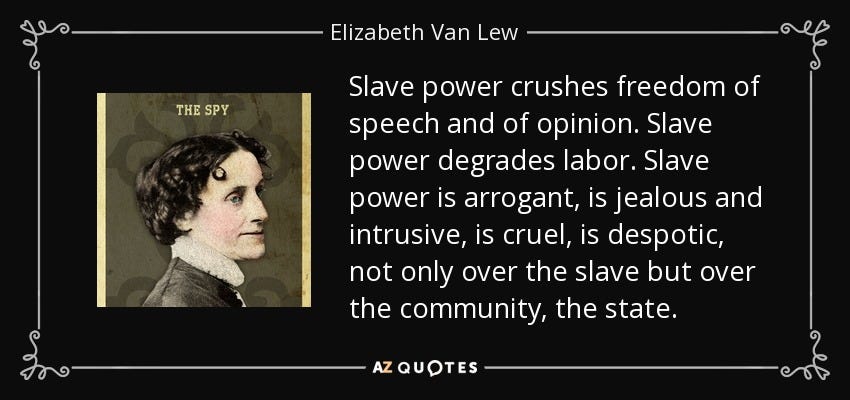Revolutions begin when dominant ideas about property rights are called into question. There can be various reforms that make adjustments to power around the edges and there can even be rebellions and revolts against the dominant power-holders. But without calling the property-power relationship (class) into question, the underlying structure of society remains in place.
As I’ve written elsewhere, the abolition of slavery in the US was radical precisely because it was an abolition of a property relation that was at the same time the foundation of a racial power relation (or, more precisely, a colonial relation). The abolition of slavery didn’t just say enslaved people should be treated better. It said that the ownership of other human beings should be completely abolished. It was an argument against a form of property that was seen as a malignant and violent evil.

The brilliance of the mass anti-slavery movement was to show how “the Slave Power” harmed not only enslaved people, but the vast majority of Americans. The enslaved were, of course, the most directly harmed by slavery. But wealth built on slavery also enabled slaveholders to buy up all the best land, which made it hard for average white people to make a living. The slave property-power relation also gave the slaveholders immense political power because the US Constitution counted enslaved people for purposes of political representation in Congress, even though enslaved people could not vote. This made the slaveholders immensely powerful politically. And they used this power to invade and colonize northern Mexico as well as pass laws that benefitted them and hurt average white people.
The abolitionist / anti-slavery movement was a massive campaign to convince the majority of Americans that the institution of slavery — the slavery property-relation — was a threat to the livelihoods of the people and the survival of democracy.
Above all, Republicans depicted the battle against slavery as a species of class struggle — a social war not simply between slaves and masters, but between the overwhelming majority of Americans and a tiny aristocracy of slave lords who controlled the federal government. In such a struggle it was obvious that large and concrete interests were directly at stake.
…From 1854 to 1860, Republican antislavery agitation — and its enthusiastic response within the Northern electorate — forcibly reorganized American political conflict around this blunt binary between “slavery” and “freedom.” As Ohio governor Salmon Chase put it during the 1856 election, “the popular heart is stirred as never before, for the issue is boldly made between Freedom and Slavery — a Republic and a Despotism! … The chain-gang and Republicanism cannot coexist, and you must now elect whether you will vindicate the one at whatever cost, or whether you will yield to the other.”
If our contemporary movements are to bring about revolutionary change in this country, we will need to build mass agitation around the property-power relation of capitalism: private ownership of productive property that should be shared by us all. Currently the mainstream critique of economic inequality is based on the politics of income: “the wealthy few are getting richer and the rest of us are getting poorer”. The demand that flows from this focus on income inequality is a return to the “good old days” of the New Deal era, when income was distributed more fairly. This is true and good, as far as it goes. But it doesn’t address the underlying property-power relation.
The underlying problem is not that the wealthy aren’t being taxed or regulated enough. The real problem is that a few people own our most important resources and use them for their private profit. What we need is the abolition of private ownership of our productive property. What we need is an honest accounting of how wealth and power was actually built in this country and how this has harmed the vast majority of people. This, then, would serve as the foundation for a new political movement for the abolition of capitalism.
Among those interested in dismantling white supremacy, truth and reconciliation and reparations processes have become an area of major interest. The basic idea is that telling the truth about the history and impacts of racism is the foundation for charting a new future. But what if the truth that needs telling is not only about race? Or rather, what if race was one dimension of a bigger story embedded in property relations and their embeddedness in a colonial structure of power? What if we built a massive campaign that exposed the history, racism, and violence of the capitalist property-power relation?
Like the movement against slavery, it’s likely that this kind of political movement would start off with a small dedicated few. And it would probably start by trying to contain capitalism the way that anti-slavery forces tried to keep slavery from expanding. But this would inevitably lead to radicalization of the struggle because those whose property-power was threatened would strike back, polarizing the issue further and forcing more and more direct confrontations.
Other posts in the Abolition & Property series
